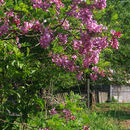Associations
provided by BioImages, the virtual fieldguide, UK
In Great Britain and/or Ireland:
Fungus / parasite
Microsphaera pseudacaciae parasitises Robinia hispida
Derivation of specific name
provided by Flora of Zimbabwe
hispida: rough with stiff hairs (hispid)
- license
- cc-by-nc
- copyright
- Mark Hyde, Bart Wursten and Petra Ballings
- bibliographic citation
- Hyde, M.A., Wursten, B.T. and Ballings, P. (2002-2014). Robinia hispida L. Flora of Zimbabwe website. Accessed 28 August 2014 at http://www.zimbabweflora.co.zw/cult/species.php?species_id=166320
- author
- Mark Hyde
- author
- Bart Wursten
- author
- Petra Ballings
Comprehensive Description
provided by North American Flora
Robinia longiloba Ashe, Bull. Charleston Mus. 14: 30. 1918
A shrub, 4-6 dm. high ; branches more or less pubescent w-ith curved hairs and short-stalked glands; stipules filiform and deciduous, rarely becoming spinose on vigorous shoots; leaves 10-15 cm. long; raehis slightly pubescent or glabrate; leaflets 7-17, oval, 3.5-5 cm. long, 1.52.5 cm. wide, rounded at each end, mucronate at the apex, glabrous above, silky-canescent beneath when young, glabrate but pale in age; racemes 9-21-flowered, 7-12 cm. long; peduncle and pedicels decidedly glandular-hispid; calyx puberulent and glandular-hispid, tinged with purple, the tube 4-6 mm. long, the lobes ovate with slender tips, 6-8 mm. long; corolla rose or purple, 18-20 mm. long; pod unknown.* (Intermediate between R. Boyntoni and R. grandiflora; perhaps a hybrid.)
Type locality: Oconee County, South Carolina. Distribution: Mountains of North and South Carolina.
- bibliographic citation
- Per Axel Rydberg. 1919. (ROSALES); FABACEAE; PSORALEAE. North American flora. vol 24(1). New York Botanical Garden, New York, NY
Comprehensive Description
provided by North American Flora
Robinia hispida L. Mant. 101. 1767
Robinia rosea Marsh. Arb. 134. 1785. Not R. rosea Mill. 1768. Pseudo-Acacia [" Pseudacacia"] hispida Moench, Meth. 145. 1794. Robinia hispida-rosea Mirb. Nouv. Duham. 2: 64. 1804. Robinia monlana Bartr.; Pursh, Fl. Am. Sept. 488. as svnonym. 1814. Robinia Unakae Ashe, Jour. Elisha Mitchell Soe. 39: 1 10. 1923.
A straggling shrub, 3-20 dm. high; branches usually densely hispid and somewhat pilose; stipular spines short, 3-5 mm. long, or wanting; leaves 1-2 dm. long; raehis usually hispid; stipels subulate-setaceous, 2-4 mm. long; leaflets 7-13, oblong-oval to suborbicular, 1.8-5 cm. long, 1-3.5 cm. wide, wholly glabrous or with scattered hairs on the veins beneath, rounded at both ends; racemes 3-5-flowered, 5-10 cm. long; peduncle, pedicels, and calyces more or less hispid; calyx-tube 6 mm. long, the lobes deltoid-lanceolate, acuminate, 6-7 mm. long; corolla 22-25 mm. long, purple or reddish-purple; pod 5-8 cm. long, 1 cm. wide, densely hispid, abruptly acuminate, 3-5-seeded.
Type locality: Carolina.
Distribution: In and near the mountains, from Virginia to Illinois, Alabama, and Georgia.
- bibliographic citation
- Per Axel Rydberg. 1919. (ROSALES); FABACEAE; PSORALEAE. North American flora. vol 24(1). New York Botanical Garden, New York, NY
Physical Description
provided by USDA PLANTS text
Perennial, Shrubs, Woody throughout, Stems woody below, or from woody crown or caudex, Plants with rhizomes or suckers, Nodules present, Stems erect or ascending, Stems less than 1 m tall, Stems 1-2 m tall, Plants gland-dotted or with gland-tipped hairs, Stems solid, Stems or young twigs sparsely to densely hairy, Leaves alternate, Leaves petiolate, Stipules conspicuous, Stipules setiform, subulate or acicular, Stipules deciduous, Stipules free, Leaves compound, Leaves odd pinnate, Leaf or leaflet margins entire, Leaflets opposite, Stipels present at base of leaflets, Leaflets 5-9, Leaflets 10-many, Leaves glandular punctate or gland-dotted, Leaves hairy on one or both surfaces, Inflorescences racemes, Inflorescence axillary, Inflorescence or flowers lax, declined or pendulous, Flowers zygomorphic, Calyx 2-lipped or 2-lobed, Calyx hairy, Petals separate, Corolla papilionaceous, Petals pinkish to rose, Banner petal suborbicular, broadly rounded, Wing petals narrow, oblanceolate to oblong, Wing tips obtuse or rounded, Keel tips obtuse or rounded, not beaked, Stamens 9-10, Stamens diadelphous, 9 united, 1 free, Filaments glabrous, Style terete, Style hairy, Style hairy on one side only, Fruit a legume, Fruit stipitate, Fruit unilocular, Fruit freely dehiscent, Fruit elongate, straight, Fruit exserted from calyx, Fruit hairy, Fruit 3-10 seeded, Seeds reniform, Seed surface smooth, Seeds olive, brown, or black.
Robinia hispida: Brief Summary
provided by wikipedia EN
Robinia hispida, known as the bristly locust, rose-acacia, or moss locust, is a shrub in the subfamily Faboideae of the pea family Fabaceae. It is native to the southeastern United States, and it is present in other areas, including other regions of North America, as an introduced species. It is grown as an ornamental and can escape cultivation and grow in the wild.
- license
- cc-by-sa-3.0
- copyright
- Wikipedia authors and editors

